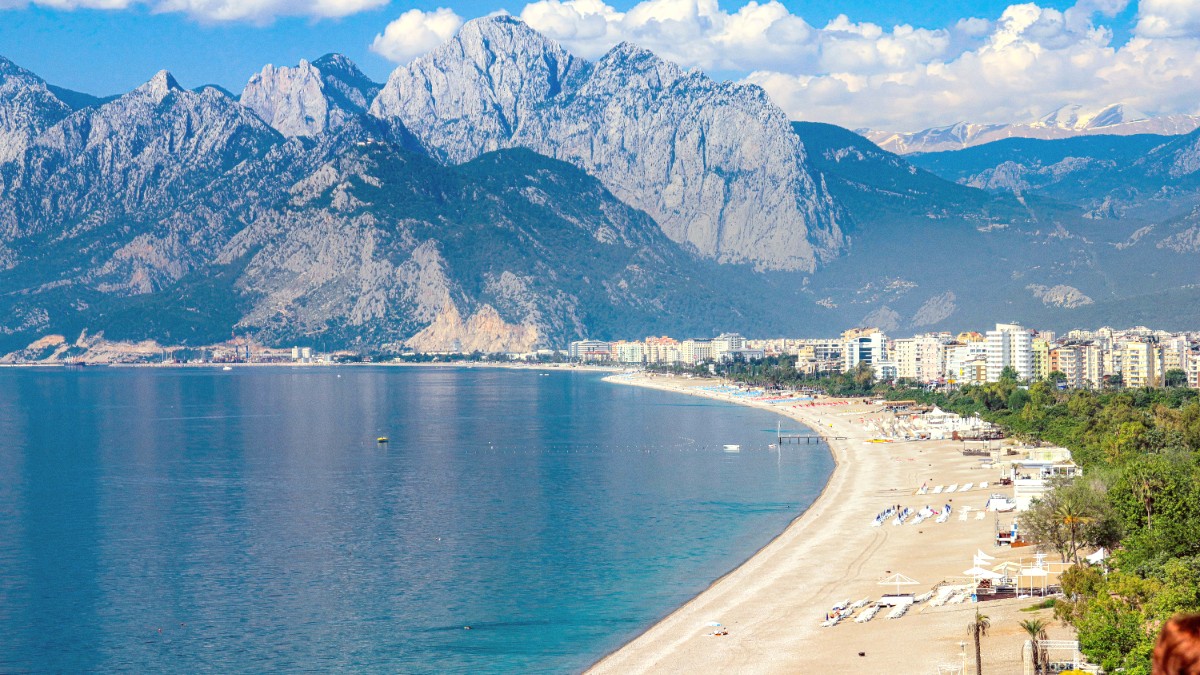
Mediterranean Coast, Turkey
The city shines as a premier destination for those who seek both relaxation and adventure. Guests enjoy days exploring Roman gates, Ottoman mansions, and bustling harbors. Evenings bring diverse dining and entertainment options. Whether your interest lies in uncovering the past, embracing outdoor activities, or simply unwinding by the sea, Antalya caters to your desires. Its blend of cultural richness, natural splendor, and lively atmosphere creates an inviting experience for all visitors. Explore a city that captivates and delights, presenting a fresh perspective on Mediterranean travel.
Antalya occupies a prime location on the southwestern coast of Turkey, gracefully curving around the Gulf of Antalya. This position places it directly on the Mediterranean Sea, guaranteeing warm waters and a sunny climate for much of the year. The city acts as the provincial capital of Antalya Province, a region celebrated for its extensive coastline, fertile plains, and rugged mountainous terrain.
To the north, the majestic Taurus Mountains form a breathtaking backdrop. The mountains shield the coastal plains from harsh northern winds, contributing to the mild winters Antalya experiences. Their peaks, some rising over 3,000 meters (9,800 feet), create distinct microclimates, permitting winter sports just a short drive from the sunny coast. The foothills are a rich source of fresh water, feeding the rivers that cascade into the Mediterranean, notably the Düden and Manavgat rivers.
Antalya boasts a long and layered history, with roots tracing back to the 2nd century BC. King Attalus II of Pergamon founded the city around 150 BC, naming it Attaleia after himself. This Hellenistic period laid the initial groundwork for a strategically significant port city. Attaleia quickly became a regional center, benefitting from its natural harbor and fertile surroundings.
The city’s prominence grew under Roman rule, starting from 133 BC. The Romans recognized Attaleia’s strategic maritime location. It functioned as a naval base and trade hub, connecting Asia Minor to the wider Roman Empire. Evidence of this powerful era remains visible today. Hadrian’s Gate, a magnificent triumphal arch built in 130 AD to honor Emperor Hadrian’s visit, is a prominent reminder of Roman influence. Following the decline of the Roman Empire, Antalya transitioned into a significant Byzantine city.
Foundation of Attaleia by King Attalus II of Pergamon.
City falls under Roman rule, becoming a port and trade hub.
Hadrian’s Gate constructed to commemorate Emperor Hadrian’s visit.
Seljuk Turks conquer Antalya, leading to a new era of prosperity and distinct architecture.
City absorbed into the Ottoman Empire, developing the charming Kaleiçi Old Town.
In the early 13th century, the Seljuk Turks conquered Antalya. This marked a major cultural and architectural shift. Under Seljuk rule, Antalya flourished as a major trading port, connecting Anatolia with the Mediterranean world. The Seljuks introduced distinct architectural styles, exemplified by the Yivliminare Mosque (Fluted Minaret), an iconic symbol of Antalya. Its unique brick minaret showcases Seljuk craftsmanship.
The Ottoman Empire eventually absorbed Antalya in the late 14th century. For centuries, the city served as an important provincial center within the vast Ottoman realm. The Ottomans continued to develop the city, notably the Kaleiçi (Old Town) area. They built charming wooden houses, mosques, and public baths, many of which remain today.
In the early 20th century, with the fall of the Ottoman Empire and the establishment of the Republic of Turkey, Antalya began its transformation into a modern city. The development of tourism in the latter half of the 20th century brought renewed prosperity and a new identity. Today, Antalya’s history resonates in the very stones of its old town, the arches of its ancient gates, and the stories told by its harbor.
Visitors experience this continuous historical narrative, walking paths trodden by countless generations and witnessing the layers of civilization that have shaped this remarkable city.
This city skillfully blends its rich past with modern amenities, presenting a comprehensive travel experience that appeals to a wide range of interests. Its reputation as the "Turkish Riviera" stems from its extensive coastline, offering abundant opportunities for sunbathing, swimming, and water sports.
The core of Antalya’s charm lies in its diverse offerings. Picture the historical district of Kaleiçi, with its winding cobblestone alleys, beautifully preserved Ottoman houses, and quaint boutique hotels. This area feels like a step back in time, providing a stark contrast to the city’s modern boulevards, upscale shopping malls, and contemporary high-rise buildings. This blend permits travelers to immerse themselves in history one moment and enjoy modern comforts the next.
Enjoy turquoise waters, beaches like Konyaaltı and Lara, and the adventure of the Taurus Mountains.
Explore ancient sites like Hadrian’s Gate, Yivliminare Mosque, Perge, and Aspendos.
Savor diverse culinary delights, lively nightlife, and modern shopping experiences.
Antalya also caters to leisure and entertainment. Its culinary scene ranges from traditional Turkish street food to fine dining, welcoming guests to savor local flavors like Piyaz (white bean salad) and fresh seafood. The city’s nightlife, centered in Kaleiçi and the resort areas, presents various options for evening enjoyment. Modern shopping centers present opportunities for retail therapy, while local bazaars present a chance to haggle for souvenirs and local crafts.